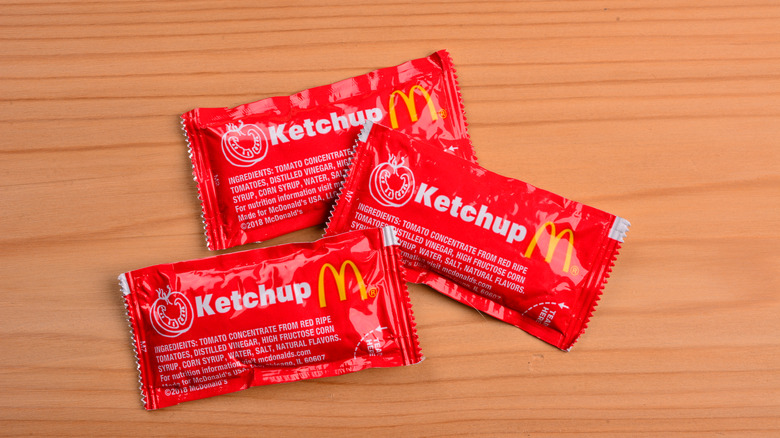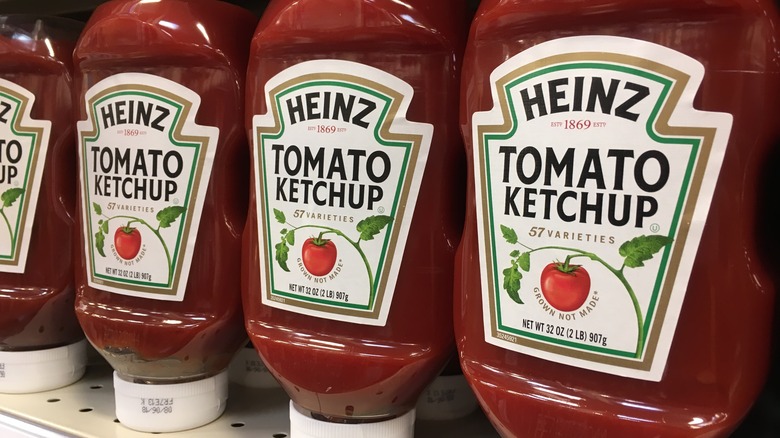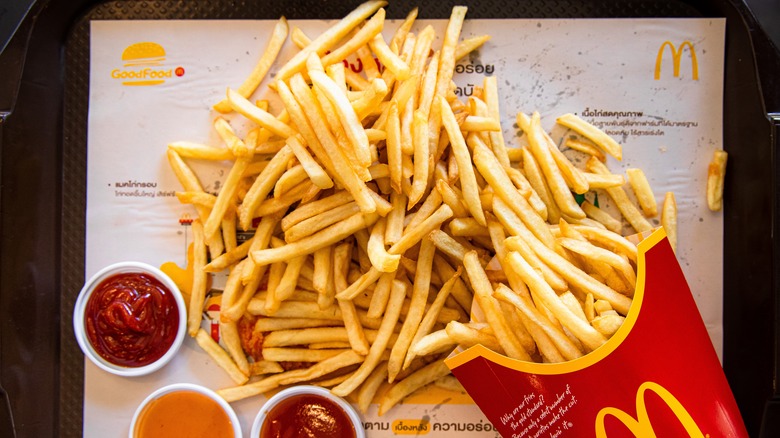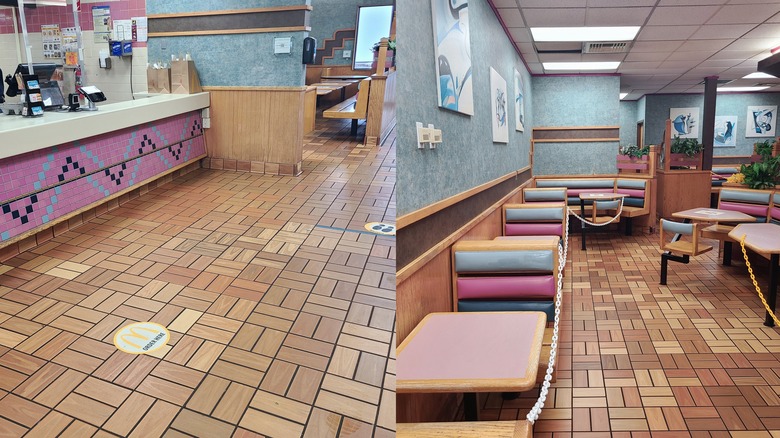The Real Reason McDonald's Stopped Serving Heinz Ketchup
You head to your local McDonald's on your lunch break and order a cheeseburger, some fries, and a Coke. Before you dig into the piping hot fries that McDonald's is so famous for, you tear open those little packets of ketchup and squeeze the tangy tomato condiment for dunking your fries. As you sit there, munching away, you notice the ketchup packets are labeled "Fancy Ketchup." "Fancy Ketchup?" you wonder to yourself. "Does McDonald's have its own private ketchup brand, or something?"
While the idea of Ronald McDonald owning a tomato farm to make his special McDonald's-brand ketchup may be an amusing thought, the truth isn't too far off. According to a self-identified former McDonald's manager on Quora, McDonald's actually makes its own ketchup. The "fancy" part of "fancy ketchup" is nothing more than a term for when ketchup meets USDA Grade A standards for tomato ketchup. But why go through all that trouble? Couldn't McDonald's just partner up with Heinz and have a limitless amount of Heinz's famous ketchup? Truth be told, Heinz and McDonald's were business partners up until 2013, when McDonald's dropped the condiment mogul to focus on preparing its own brand of ketchup.
Why, exactly, would such a prosperous partnership come to an end? The answer involves the then-CEO of Heinz and his connection to one of Ronald's biggest rivals.
Former Heinz CEO Bernardo Hees worked at Burger King
In 2013, McDonald's announced an end to a 40-year-long partnership with Heinz Foods (per Food Business News), the reason relating to the company's new CEO at the time. The CEO, Bernardo Hees, wasn't a controversial figure or a reckless businessman. But in the eyes of Ronald McDonald, he was no less an enemy. You see, before taking on the mantle of Heinz CEO, Hees worked as the worldwide CEO of Burger King. Hees was credited with evolving Burger King's menu and getting rid of the infamous "King" mascot, per the South Florida Business Journal.
Although one would believe a track record such as Hees' would be something to be excited by, McDonald's didn't seem to view it that way. Why would the company want to partner with someone who worked to make its rival company better? In a statement regarding the split, McDonald's cited "recent management changes in Heinz" as the primary reason for ending the partnership (via CNBC) and said that Heinz will work with McDonald's to ensure an orderly transition. The decision to remove Heinz ketchup from the menu, McDonald's assured customers, wouldn't affect the business, the customers, or the "great-tasting food at McDonald's."
Heinz gave its company policy of keeping customer-to-business relationships confidential as a reason for not discussing the "breakup." And believe us, breaking up is hard to do.
McDonald's changed its fry recipe, too
Okay, so McDonald's changed its ketchup. No big deal, you might say — it's not like the menu changed, right?
If you're an older fan of McDonald's and have a particularly refined palate, you may have noticed that the chain's famous golden fries taste just a bit different these days. According to SFGate, McDonald's fries were originally fried in beef tallow, a type of animal fat that becomes semi-solid at room temperature. The tallow was originally used when McDonald's opened in the 1940s because it was the cheapest option its oil supplier could give them. Fortunately for the McDonald brothers (and fry-lovers all over), the tallow had the added effect of giving the fries their signature golden brown, rich, flavor that would excel them to legendary status. But if the tallow-frying method was so popular, why stop?
In 1965, businessman Phil Sokolof had a heart attack. Sokolof's subsequent health crisis inspired him on a health-focused crusade, and he created ads targeting fast-food chains such as McDonald's for their unhealthy business practices, per The Washington Post. McDonald's reportedly denied that Sokolof's ads were the cause of its fry recipe change, per the Los Angeles Times, but the fast-food industry still felt his influence. And in the 1990s, McDonald's stopped using beef tallow to cook its spuds, instead using vegetable oil. It may not be the same as beef tallow — and McDonald's fries definitely taste different now — but, hey, at least they're somewhat better for you.
It wasn't just the ketchup and fries that changed
Go out and take a stroll into your local McDonald's. Look around you — you can smell the fries and the grease, can't you? You can see the people in line waiting to pick up food like so many before them. But something is off. Where are Ronald McDonald and his pals? Where are the booths with those pastel-colored cushions? Where are those old Nintendo game pavilions where you and your buds would play Mario Kart? Everything now feels so sleek, so modern. Wood-panel walls, hanging plants, minimalist art, soft lighting — it feels more like a trendy restaurant than the beloved nirvana of Happy Meals and cartoon characters like Grimace and the Hamburglar.
In 2018, McDonald's launched a $6 billion overhaul for more than 8,700 U.S. restaurants as part of a "modernization" campaign, per Food Business News. This involved updating dining rooms, as well as adding self-ordering kiosks and curbside pick-up. Ronald McDonald, already under fire for promoting unhealthy food to children, simply wouldn't fit in the ultra-modern vibe McDonald's was trying to put on. People no longer wanted McDonaldland; they wanted comfort and class. If they were going to eat at McDonald's, the company could make it feel trendy and hip instead of a cheesy, pastel-colored circus.
Still, nostalgic fans can hold out hope that one day, they'll dip their beef tallow fries into Heinz ketchup and find peace in the "'90s-revivalist style" McDonald's will adopt.



